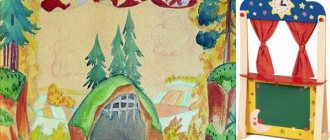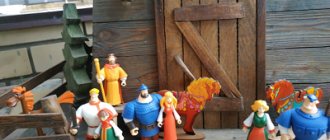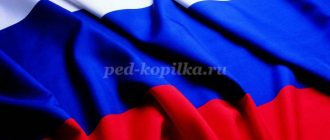"Russian folk tales"
Project work of 6th grade students
Topic: “Russian folk tales.” Creative title: “A fairy tale is a lie, but there is a hint in it, a lesson to good fellows!”
The fundamental question: “What is a fairy tale?”
Student research topics: “What types of fairy tales are divided into?”
I Problematic question: “When did fairy tales come into your life?”
Project goal: To develop creative thinking in participants, the ability to acquire knowledge from various sources, analyze facts, make generalizations, and develop general educational skills.
Formation of creative groups.
Design of projects (slides)
Group I. Fairy tales (Malaeva R)
Fairy tales are divided into magical, social and everyday tales and tales about animals.
Fairy tales involve people and fantastic creatures, and victory is achieved through sorcery.
There are many wonderful and extraordinary things in fantastic fairy tales. Good and evil wizards act in them: Baba Yaga, Koschey the Immortal, an airplane carpet, walking boots, a magic mirror and other creatures and objects endowed with supernatural powers.
In fairy tales, people can turn into animals, and animals and birds can speak human language. But these fairy tales are always based on phenomena of real life.
For example, in Morozko. Frost - The red nose gives wealth to the poor girl, the dog talks to her stepmother.
However, along with this, the fairy tale gives a truthful depiction of life, showing the relationship between stepmother and stepdaughter, which actually often happened in the old family.
The heroes of the fairy tale “The Frog Princess” are Vasilisa the Wise, transformed into a frog, and Ivan, the prince, with whom extraordinary adventures occur. But modesty, kindness and courage help Ivan, the prince, to overcome all obstacles and find his wife Vasilisa the Wise.
Positive heroes of fairy tales - Ivan the fool, Vasilisa the Wise, Marya Morevna, the youngest son and brother, the persecuted orphan, etc. etc.
Fantastic creatures act as enemies of the positive characters: the Serpent, Koschey, Dashing One-Eyed, the Sea King, Baba Yaga.
The conflict in a fairy tale develops with the help of wonderful, wonderful helpers (a horse, a frog, a kind old woman, a sorceress wife), wonderful objects (a purse - a self-shaker, a tablecloth - a self-assembly, a club - a self-breaker, a harp - a samogud, etc.)
Features that define the poetics of a fairy tale: verbal formulas, triple repetitions, slow-motion technique - retardation, constant epithets, saying, ending. A fairy tale is usually longer than other types of fairy tales.
The most popular fairy-tale stories are about the three princesses, about Sivka-Burka, about Koshchei the Immortal, about a boy and a witch, about a magic ring, about a stepmother and stepdaughter, about animal milk, about a frog princess.
In the wonderful fictions of fantastic fairy tales “Morozko”, “The Frog Princess”, “The Sea King and Vasilisa the Wise”, “Marya Morevna”, “Ivashka and the Witch”, “Sivka-Burko”, “Ivan the Tsarevich and the Miracle Yudo” and others, the people embodied dreams of a future fair, happy life, of free, interesting, facilitated human labor, and expressed confidence in the triumph of truth and goodness.
Project “Journey through Russian folk tales”
Municipal budget preschool institution
CRR kindergarten No. 51 “Rodnichok”, first category
Author:
Redhead Marina Vladimirovna, teacher
With. Kagalnik
2020 year
Why do we need fairy tales?
What does a person look for in them? Maybe kindness and affection. Maybe yesterday's snow. In a fairy tale, joy wins, A fairy tale teaches us to love...
Introduction
A fairy tale is a necessary element of a child’s spiritual life. Entering the world of miracles and magic, the child plunges into the depths of his soul. Russian folk tales, introducing children to the circle of extraordinary events and transformations that occur with their heroes, express deep moral ideas. They teach kindness towards people, show high feelings and aspirations. Meeting children with fairy tale heroes will not leave them indifferent. The desire to help a hero in trouble, to understand a fairy-tale situation - all this stimulates the child’s mental activity and develops interest in the subject. As a result of empathy, the child acquires not only new knowledge, but also, most importantly, a new emotional attitude towards the environment: people, objects, phenomena. From fairy tales, children draw a lot of knowledge: their first ideas about time and space, about the connection between man and nature, the objective world. Preschoolers are faced with such complex phenomena and feelings as life and death, love and hate; anger and compassion, betrayal and deceit. The form of depiction of these phenomena is special, fabulous, understandable to a child, and the height of the manifestations and the moral meaning remain genuine, “adults”. Therefore, the lessons that the fairy tale gives are lessons for life.
The project “Travels through Fairy Tales” is carried out as an exciting game, creative activity aimed at enhancing verbal, social and communicative communication. The integration approach allows you to develop in unity the child’s speech, creative abilities, communication skills, and emotional responsiveness.
Project passport
Project topic:
"Travels through fairy tales."
Project type:
long-term, creative, collective, with the participation of the students’ parents.
Project implementation period:
constantly.
Event location:
MBDOU kindergarten No. 51 “Rodnichok”,
Project participants:
children of senior preschool age, parents of preschool children, teachers
Target:
Introducing preschool children to folk culture through familiarization with Russian folk tales and small folklore forms.
Tasks:
1. Acquaintance with Russian folk tales 2. Expansion of vocabulary 3. Development of creative abilities
4. Ensuring the relationship between speech, theatrical, musical and artistic activities
Group II. Tales about animals. ()
From childhood, everyone is familiar with such fairy tales about animals as “Teremok”, or about a fox who, pretending to be dead, steals fish from a man’s cart, about a stupid wolf who, on the advice of a cunning fox, caught fish by lowering his tail into an ice hole.
If in fairy tales the storyteller narrates slowly about magical adventures, but the manner of fairy tales about animals changes. His voice seemed to disappear, but instead of his voice several new and very memorable ones appeared: “fat” - this is said by the bear, the owner of the forests; “sweet with cunning” is a fox. Lisa Patrikeevna, the fox's gossip; In a “thin” voice, the bunny – the little bunny – the little runaway conducts conversations. One of the fairy tales about animals is “The Crane and the Heron”
Creative projects and student work
The student creative project “Russian folk tales” is an example of a children’s project on the topic “Russian folk tales” and contains a description of the goals, objectives, object and subject of creative work on literary reading (literature), as well as the definition and analysis of Russian folk tales.
More details about the project:
Work on a creative project on the topic “Russian folk tales” can also be organized for kindergarten students with the participation of the teacher and parents.
Table of contents
Introduction 1. History of Russian folk tales. 2. Types of Russian folk tales. 2.1. Russian folk fairy tales 2.2. Russian folk tales from everyday life. 2.3. Russian folk tales about animals. Conclusion Literature Appendix 1. Fairy tales of 3rd grade students. Appendix 2. Illustrations for Russian folk tales.
Introduction
Fairy tales are different. Folk tales are divided into tales about animals, fairy tales, and everyday tales. In some, the main characters are animals (sometimes they are opposed by humans). These are tales about animals.
And finally, there are fairy tales, the main characters of which are also people, but, unlike fairy tales, where the heroes win
Speaking about the differences between fairy tales, it is interesting to pay attention to the origins of their fiction, fantasy. Why do animals in fairy tales talk like people, why does a deceased father reward his youngest son with a Sivka Burka, why does a comb thrown back turn into a forest? These and many other questions will remain unanswered if we do not turn to that era in human life when there were no fairy tales yet, but there were oral stories about people’s faith in all kinds of miracles.
Everything that has been said explains to us why animals talk in fairy tales, why in the fairy tale “Sivka-Burka” the deceased father talks with his youngest son. Scientists have also established that the Serpent, Gorynych in fairy tales is the personification of fire, the images of Baba Yaga and Koshchei the Immortal are associated with the cult of ancestors, etc.
But all this speaks only about the origins of the fantasy of fairy tales.
Speaking about fairy tales of different peoples with similar plots, it is necessary to note three cases:
The national features of a fairy tale are determined by the folklore traditions of the people. Fairy tales reflect the animal and plant world of the country where these fairy tales appeared. Animals - the heroes of fairy tales - in their speech and behavior resemble the people of the country where these fairy tales exist. And it cannot be otherwise, since a fairy tale has always been a reflection of people's life, a mirror of people's consciousness.
Source
Project “Russian folk tales” in the preparatory group
Yana Sharova
Project “Russian folk tales” in the preparatory group
Project “ Russian folk tales ”
Project type : Short term
Project type : educational, creative, gaming.
Duration: 1 month
Project participants : children of the preparatory group , parents, teachers.
People have created wonderful fairy tales , songs, riddles, and sayings for children Works of folk art have not lost their impact on children today. The fairy tale speaks simply and convincingly about the victory of good over evil, truth over lies, and the triumph of justice. The positive hero of a fairy tale always wins .
Thanks to the fairy tale , the child learns and expresses his own attitude towards good and evil. Even children of older groups believe in fairy tales , which means that it is easier to teach and educate through it. Children learn to analyze and evaluate the behavior of characters, develop the ability to feel and understand others.
Project goal : To introduce children to Russian folk tales .
Tasks:
- to form children’s knowledge about Russian folk tales ;
- to cultivate a love for fairy tales , folk art , and artistic expression;
* teach children to evaluate the actions of heroes;
- develop speech, activate vocabulary;
-promote the development of joint creativity between parents and children;
- to arouse parents’ interest in life in a preschool educational institution and the desire to participate in it.
Project implementation stages :
Preparatory stage:
-change the subject-development environment in the group in accordance with the program;
-select exhibits to create a mini-museum of fairy tales ;
-organize an exhibition of drawings “ Fairy-tale heroes ”
by teachers, children and their parents;
-exhibition of books on Russian folk tales
- select Russian folk tales and illustrations for them ;
-reading Russian folk tales and then watching cartoons based on them;
- select coloring pages based on Russian folk tales ;
— find out from children and parents what books they read at home, whether there are fairy tales .
-ask parents and their children to take part in the production of books for the exhibition, and also to take part in the “Give a book to a kindergarten with an autograph”
.
Main stage:
Work with children:
1. presentations; conversations; conversation about rules of behavior using the plot of fairy tales ; watching cartoons based on fairy tales ; dramatization of fairy tales ;
showing fairy tales in tabletop theaters; showing fairy tales using a finger theater; reading fairy tales and discussing their content;
comparison of the content of fairy tales read and viewed; inventing other endings to fairy tales ; retelling of fairy tales ; telling a fairy tale using illustrations ; conducting a quiz on Russian folk tales and a quiz “Guess the fairy-tale hero ”
.applique; subject drawing.
Independent activities:
- coloring of coloring books;
- modeling of fairy-tale characters ;
Working with parents:
-participation of parents and children in the design of the book and drawings “Our Favorite Fairy Tales ”
;
— participation of parents in replenishing the puppet theater group ;
-participation of parents in the “Give a book with an autograph”
.
The final stage:
-creation of the “ Fairy Tales ”
;
- registration of drawings of children and parents in the book “ Fairy-Tale Heroes ”
;
- making a book based on fairy tales .
-An evening of entertainment viewing
fairy tales "The Magic World of Fairy Tales "
.
Planned result:
-development of interest in Russian folk art ;
— development of emotional responsiveness;
- the child’s positive attitude towards the world around him, other people and himself
Literary reading project on the topic “Russian folk tales” (grade 3)
art therapy specialist
Document selected for viewing Project Levchenko Anastasia.ppt
Description of the presentation by individual slides:
Reading project “Russian folk tales” Prepared by: student 3 “A” of class MBOU secondary school No. 49 in Shakhty Levchenko A. Teacher: Tarasenko T.N. 2014-2015 academic year G.
There are many fairy tales in the world, sad and funny. We can't live without light, We can't live without them. May the heroes of fairy tales Give us warmth, May Good triumph over evil forever!
Types of fairy tales about animals; magical; social and household.
Good fairy-tale heroes
Evil fairy tale characters
Who is the great washbasin, the chief of washbasins? Who is the commander of the washcloths? This is kind. Riddles of Moidodyr
It's mixed with sour cream, It's cold on the window, The round side, the ruddy side Rolls. Kolobok
Everyone knows in Rus', They were waiting for mother with milk, And they let a wolf into the house. Who are these Little Children? Seven kids
An arrow flew and fell into a swamp, and in that swamp someone caught it. Who, having said goodbye to her green skin, instantly became beautiful and comely? Princess Frog
The fairy tale is a lie, but there is a hint in it! A lesson to good fellows. The fairy tale is a lie, but there is a hint in it! A lesson to good fellows.
A literary reading project on the topic “Russian folk tales” was prepared by 3rd grade student Anastasia Levchenko. The presentation contains general information about folk tales, types of fairy tales, and the heroes of these works. The student picked up riddles about fairy tales and their heroes, which are accompanied by bright illustrations. In the appendix to the presentation you can find the wonderful song “Fairy tales walk around the world.”
Material number: 290678
Didn't find what you were looking for?
You might be interested in these courses:







